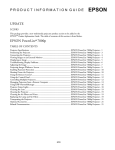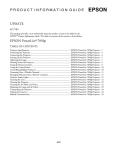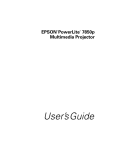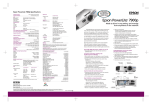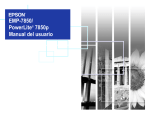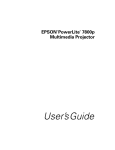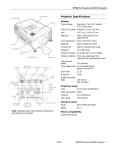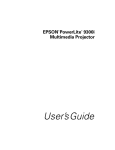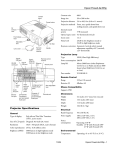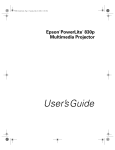Download Epson 7900p - PowerLite XGA LCD Projector Specifications
Transcript
Epson PowerLite 7900p Projector
Temperature light
Focus ring
Zoom ring
4000 ANSI lumens in high brightness
mode; 3000 ANSI lumens in low
brightness mode
Contrast ratio
700:1
Image size
30 to 300 inches
Power
light
Lamp light
Air exhaust
vent
Brightness
Control panel
Projection distance 2.5 to 36.5 feet (0.8 to 11.1 meters)
Remote
control
receiver and
Wall Shot lens
Projection methods Front, rear, and ceiling mount (upsidedown front or rear)
Internal sound
system
Foot
release lever
Optical aspect ratio 4:3 (horizontal:vertical)
Front adjustable
foot
Noise level
Air filter
Keystone
correction angle
RJ-45 Ethernet port
(for wired LAN)
RS-232
serial port
DVI port
Computer
port
Type B
USB port
Remote control
receiver
Kensington®
security lock
Speaker
Video port and
related audio
ports
Rear
adjustable
foot
Power inlet
Audio-in port (for
Computer and DVI)
±40° vertical, ±20° horizontal
(automatically adjusts vertical angle)
Type
UHE (Ultra High Efficiency)
Power
consumption
250 W
Lamp life
About 2000 hours (high brightness
mode); 3000 hours (low brightness
mode
Part number
V13H010L22
Remote Control
BNC ports (Comp2 or Component)
Monitor-out port
36 dB in high brightness mode;
33 dB in low brightness mode
Projection Lamp
Remote port
Audio-out port
5 W monaural
S-Video port and
related audio ports
Range
33 feet (10 meters)
Battery
Alkaline AA (2)
Dimensions
Projector Specifications
Height
4.6 inches (117 mm), feet retracted
Width
16.5 inches (419 mm)
Depth
12.8 inches (325 mm)
Weight
12.3 lb (5.6 kg)
Mouse Compatibility
General
Type of display
Poly-silicon Thin Film Transistor
(TFT), Active Matrix
Lens
F=1.7 to 2.3, f=28 to 37 mm
Zoom ratio
1:1.35
Resolution
1024 × 768 pixels (native format)
Supports USB (Type B)
Electrical
Color reproduction 24 bit, 16.7 million colors
9/04
Rated frequency
50 to 60 Hz
Power supply
100 to 120 VAC, 50/60 Hz
200 to 240 VAC, 50/60 Hz
Power
consumption
1.6 to 3.6 A, 50/60 Hz
Epson PowerLite 7900p Projector - 1
Epson PowerLite 7900p Projector
Environmental
Temperature
Although images are displayed at the projector’s native
resolution of 1024 × 768 pixels, Epson’s patented SizeWise™
chip supports computer display formats.
Operating: 41 to 104 °F (5 to 40 °C)
Storage: 14 to 140 °F (–10 to 60 °C)
Humidity
To project images output from a computer, the computer’s
external monitor signal must be set at a refresh rate (vertical
frequency) that’s compatible with the projector; see the
following table for compatible formats. For best results, the
computer’s resolution should be set to 1024 × 768.
Operating: 20 to 80% RH,
non-condensing
Storage: 10 to 90% RH,
non-condensing
Safety
Mode
Refresh rate (Hz)
Resolution
FCC 47CFR Part 15B Class B (DoC)
UL60950 Third Edition
VGAEGA
70
640 × 350*
VGA—60
60
640 × 480*
ICES-003 Class B
CSA C22.2 No. 60950
VGA—72
72
640 × 480*
VGA—75
75
640 × 480*
Directive 73/23/EEC, 89/336/EEC
EN 55022, EN 55024
VGA—85
85
640 × 480*
VGA—100
100
640 × 480*
VGA—120
120
640 × 480*
Compatible Video Formats
SVGA—56
56
800 × 600*
You can use any of the following video sources: VCR, DVD
player, camcorder, digital camera, gaming console, or laser
disc player. The projector supports composite video, S-Video,
component video, and RGB video, and it automatically senses
the video format (HDTV, SDTV, NTSC, PAL, or SECAM).
SVGA—60
60
800 × 600*
SVGA—72
72
800 × 600*
SVGA—75
75
800 × 600*
SVGA—85
85
800 × 600*
SVGA—100
100
800 × 600*
SVGA—120
120
800 × 600*
XGA—60
60
1024 × 768
XGA—70
70
1024 × 768
XGA—75
75
1024 × 768
XGA—85
85
1024 × 768
XGA—100
100
1024 × 768
XGA—120
120
1024 × 768
70
1152 × 864*
United States
Canada
CE Marking
The projector supports these international video standards:
Mode
NTSC
Refresh rate (Hz)
60
NTSC 4:43
60
PAL
50
M-PAL
60
N-PAL
50
SXGA1—70
PAL—60
60
SXGA1—75
75
1152 × 864*
SECAM
50
SXGA1—85
85
1152 × 864*
SXGA1—100
100
1152 × 864*
SXGA2—60
60
1280 × 960*
SXGA2—75
75
1280 × 960*
SXGA2—85
85
1280 × 960*
50
SXGA3—60
60
1280 × 1024*
50
SXGA3—75
75
1280 × 1024*
SXGA3—85
85
1280 × 1024*
SXGA+—60
60
1400 × 1050*
SXGA+—75
75
1400 × 1050*
SXGA+—85
85
1400 × 1050*
UXGA—60
60
1600 × 1200*
UXGA—65
65
1600 × 1200*
UXGA—70
70
1600 × 1200*
UXGA—75
75
1600 × 1200*
UXGA—80
80
1600 × 1200*
UXGA—85
85
1600 × 1200*
HDTV (720p)
60
HDTV (1080i)
60
SDTV (480i)
60
SDTV (480p)
SDTV (625i)
SDTV (625p)
60
Compatible Computer Display Formats
You can connect the projector to a wide range of computers,
®
including PCs and notebooks, Apple Macintosh, Power
®
Macintosh series (including G3 and G4 systems),
®
®
®
PowerBook computers, many iMac and iBook series
®
systems, and high-end workstations such as the Sun
™
SPARCstation.
2 - Epson PowerLite 7900p Projector
9/04
Epson PowerLite 7900p Projector
Mode
Refresh rate (Hz)
Resolution
MAC13
67
640 × 480*
MAC16
75
832 × 624*
MAC19
75
1024 × 768
MAC21
75
1152 × 870*
Calculating Image Size and Projection
Distance
Use the formulas below either to find out how large your
image will be when you know the distance from the projector
to the screen, or to find out how far from the screen to place
the projector if you want an image of a certain size. Since the
size of the image can be changed by rotating the zoom ring,
formulas are given for calculating both the minimum and
maximum sizes.
* The image is resized using Epson’s SizeWise Technology.
Positioning the Projector
Note: The formulas given here are for when the projector is placed
flat, without tilting it up at the screen. If you tilt it up by
extending the feet or use electronic keystone correction, your image
size may vary.
Follow these guideline when deciding where to place the
projector:
❏ Place the projector on a sturdy, level surface.
Wide Throw Zoom Lens (V12H004W03)
❏ Make sure there is plenty of space for ventilation around
and under the projector. Do not set it on top of anything
that could block the vents under the projector.
To determine the diagonal size of an image (in inches) when
you know the projection distance:
❏ Make sure the projector is within 10 feet of a grounded
electrical outlet or extension cord.
❏ Maximum diagonal size =
(((2.54 × projection distance) / 100) × 36) + 2.13
Image size increases with distance, but varies depending on
how you’ve adjusted the optical zoom and other settings.
❏ Minimum diagonal size =
(((2.54 × projection distance) / 100) × 26.84) + 1.29
To determine the projection distance (in inches) when you
know the diagonal size of the screen image:
TBD
❏ Maximum projection distance =
(((diagonal size – 1.29) / 26.84) × 100 / 2.54
❏ Minimum projection distance =
(((diagonal size – 2.13) / 36) × 100 / 2.54
27 to 36.5 ft
5.3 to 7.2ft
2.5 to 3.5 ft
Middle Throw Zoom Lens (V12H004M03)
approx. distance
from screen
To determine the diagonal size of an image (in inches) when
you know the projection distance:
It’s best to place the projector directly in front of the center of
the screen, facing the screen squarely. If it isn’t placed this
way, the image will be “keystone” shaped, instead of
rectangular.
❏ Maximum diagonal size =
(((2.54 × projection distance ) / 100) × 27.42) + 1.49
Minimum diagonal size =
(((2.54 × projection distance) / 100) × 20.48) + 1.1
To determine the projection distance (in inches) when you
know the diagonal size of the screen image:
Screen
❏ Maximum projection distance =
(((diagonal size – 1.1) / 20.48) × 100 / 2.54
Projector
❏ Minimum projection distance =
(((diagonal size – 1.49) / 27.42) × 100 / 2.54
Overhead View
If you place the projector below screen level, you’ll have to tilt
it up by extending the front adjustable foot. This also causes
the image to lose its rectangular shape. To correct distortion,
see “Adjusting the Image Shape” on page 7.
9/04
Epson PowerLite 7900p Projector - 3
Epson PowerLite 7900p Projector
Long Throw Zoom Lens (V12H004L05)
The projector should automatically detect the correct source.
To determine the diagonal size of an image (in inches) when
you know the projection distance:
Note: If it fails to detect the source, make sure the Computer
Input and BNC Input options in the Setting menu are set to
Auto. See the User’s Guide for more information.
❏ Maximum diagonal size =
(((2.54 × projection distance) / 100) × 20.4) + 1.93
If necessary, you can switch to the correct source by pressing
the corresponding source button on the remote control or
projector. See page 5 for details.
❏ Minimum diagonal size =
(((2.54 × projection distance) / 100) × 15.23) + 1.45
To determine the projection distance (in inches) when you
know the diagonal size of the screen image:
Playing Sound Through the Projector
You can play sound through the projector’s speaker system or
you can attach an external speaker system.
❏ Maximum projection distance =
(((diagonal size – 1.45) / 15.23) × 100 / 2.54
You can use either of these commercially available audio
cables:
❏ Minimum projection distance =
(((diagonal size – 1.93) / 20.54) × 100 / 2.54
❏ If your computer or video equipment is connected to the
Computer or DVI port, use a stereo mini-jack cable.
❏ If your equipment is connected to the Video or S-Video
port, or to the BNC ports, use an RCA-style audio cable.
Connecting the Projector
You can connect the projector to three computer sources or
four video sources—up to a total of four sources altogether.
You can include an independent sound channel for each
source. (See the Quick Setup poster or the User’s Guide for
complete setup instructions.)
Using the Remote Control as a Wireless
Mouse
If you’ve connected a computer to the projector, you can
use the projector’s remote control as a wireless mouse by
connecting a USB cable to both the projector and your
computer. The wireless mouse function is supported on
systems with a USB port running Windows XP, 98, 2000, or
Me; or Macintosh OS 8.6 to OS X 10.2. See the User’s Guide
for details.
Note: The preview feature lets you see all the sources at a glance,
so you can easily switch among them. See page 5.
Types of Connections
The following types of connections are possible, depending on
the kinds of signals your equipment generates and its available
output ports.
Viewing Images on an External
Monitor
Computer equipment
Output signal
Required cable
Analog RGB video
VGA cable
BNC cable
VGA-to-BNC cable
DVI
DVI-D dual-link cable (DVI-to-DVI or
DFP-to-DVI available from Epson)
You can use an external monitor to display images from any
connected computer source. This lets you view your
presentation close-up, as well as on the projection screen.
Note: Some LCD monitors may not be able to display the image
correctly. If you have trouble displaying the image, connect a
multiscan monitor. If you’re projecting computer images, make
sure the computer’s refresh rate is set to 65 Hz or greater.
Video equipment
Output signal
Required cable
Composite video
RCA video cable
S-Video
S-Video cable
Component video—
NTSC (YCbCr)
BNC cable
Component video—
HDTV (YPbPr)
BNC cable
RGB video
VGA cable
BNC cable
4 - Epson PowerLite 7900p Projector
The Monitor Out port will not display images from a video
source.
9/04
Epson PowerLite 7900p Projector
To use an external monitor, connect it to the projector’s
Note: If you’re using the remote control,
make sure batteries are installed and the
power switch on the side of the remote
control is turned on.
Monitor Out port, as shown:
The P power light flashes green as the projector warms up.
When the P power light stops flashing and remains green
(in about 20 seconds), the projector is ready for use.
External monitor
Warning: Never look into the lens when the lamp is on. This
can damage your eyes.
5. If you’ve connected a Windows-based computer to the
projector, you may see a New Hardware Wizard saying
your computer has found a plug-and-play monitor; if so,
click Cancel.
Follow these guidelines when using an external monitor:
Selecting the Image Source
❏ The monitor displays the currently selected computer
source. Press the Preview button on the remote control if
you want to display all the active sources at once (see
“Previewing Image Sources” on this page).
If multiple devices are connected to the projector, you can use
the Source buttons on the projector or the remote control to
switch from one source to another:
❏ If you want, you can view (or preview) images on the
monitor while the projection screen is darkened by pressing
the A/V Mute button.
❏ The projector has two Source buttons.
Use the Computer/DVI button to
switch between equipment
connected to the Computer and
DVI ports.
❏ You can also view images on the monitor while the
projector is in standby mode (plugged in but not turned
on). Set the Standby Mode setting to Network ON in the
Advanced1 menu.
Use the Video/BNC button to switch
between equipment connected to the
Video, S-Video, and BNC ports.
❏ The remote control has five
Source buttons you can use to
switch between equipment
connected to the port identified
on each button. (The PowerLite
7900p does not support
EasyMP.™ )
Displaying an Image
If you turn on your computer or video equipment before
turning on the projector, the projector automatically selects
the connected source. If you turn on the projector first or you
have multiple sources connected, you may have to switch to
the desired source manually (see “Selecting the Image Source”
on this page).
You can preview all sources to help you select the desired
source, as described below.
Turning On the Projector
It is recommended that you leave the Computer Input and
BNC Input options in the projector’s Setting menu set to
Auto.
1. Remove the lens cap.
2. Plug in the projector.
3. Wait a few seconds until the P power light stops flashing
and turns orange.
Previewing Image Sources
You can use the Preview function to help you select the image
source when you have connected multiple sources to the
projector.
4. Press the red P Power button on top of the projector or on
the remote control.
1. Press the Preview button on the
remote control.
Preview
9/04
Epson PowerLite 7900p Projector - 5
Epson PowerLite 7900p Projector
The Projector and Computer Don’t
Display the Same Image
You see the currently selected source displayed in the main
window, as shown below. All other sources (including the
currently selected source) are displayed in smaller preview
windows on the right side and at the bottom.
If you don’t see the same image on the projection screen and
on your computer screen, follow these guidelines.
If you’re using a Windows notebook computer:
Currently selected source
❏ On most systems, there’s a function key that lets you toggle
between the LCD screen and the projector, or display on
both at the same time. It may be labeled CRT/LCD or with
an icon such as
. You may have to hold down the Fn
key while pressing it. Allow a few seconds for the projector
to sync up after changing the setting.
Computer (Analog-RGB)
Computer
DVI
BNC
Video
❏ If the function key doesn’t permit you to display
simultaneously on both screens, you should check your
monitor settings to make sure both the LCD screen and the
external monitor port are enabled. From the Control Panel,
open the Display utility. In the Display Properties dialog
box, click the Settings tab, then click Advanced. The
method for adjusting the settings varies by brand; you may
need to click a Monitor tab, then make sure the external
Monitor port is set as your primary display and/or enabled.
See your computer’s documentation or online help for
details.
S-Video
Preview windows
If no equipment is connected to a port, or if there is no
incoming signal, the preview window for that source
appears blank.
Note: Movies are displayed as still images on the preview
screen.
2. Press the corresponding Source buttons on the remote
control to switch to the desired source. Or press the ESC
button to exit the preview screen without switching sources.
If you're using Macintosh OS X:
You may need to set up your system to display on the
projector screen as well as the LCD screen. Follow these steps:
Note: A red highlight surrounds the preview window for the
currently selected source. You can use the
pointer button on
the remote control to highlight a different source, and then press
Enter to display it.
1. From the Apple menu, select System Preferences, then
select Displays.
2. Make sure the VGA Display dialog box is selected.
3. Click the Arrange tab.
Troubleshooting Display Problems
Select the
VGA Display
dialog box
You Can’t Project an Image
If you see a blank screen or a blue screen with the No Signal
message, try the following:
Click the
Arrange tab
❏ Make sure the cables are connected correctly.
❏ Make sure the P power light is green and not flashing and
the lens cap is off.
❏ If you’ve connected more than one computer and/or video
source, you may need to press one of the Source buttons
on the projector’s control panel or the remote control to
select the correct source. (Allow a few seconds for the
projector to sync up after pressing the button.)
Make sure Mirror Displays is checked
4. Make sure the Mirror Displays checkbox is selected.
If you’re using OS 8.6 to 9.x:
❏ If you’re using a Windows notebook computer, press the
function key on your keyboard that lets you display on an
external monitor. It may be labeled CRT/LCD or have an
icon such as
. You may have to hold down the Fn key
while pressing it. Allow a few seconds for the projector to
sync up after changing the setting.
6 - Epson PowerLite 7900p Projector
You may need to set up your system to display on the
projector screen as well as the LCD screen. Follow these steps:
1. From the Apple menu, select Control Panels, then click
Monitors or Monitors and Sound.
9/04
Epson PowerLite 7900p Projector
2. Click the Arrange icon.
Use the Zoom ring on the projector to reduce or enlarge the
projected image. Move the tab toward the W to make it
bigger, or toward the T to make it smaller.
Click here
If the image still isn’t large enough, you may need to move the
projector farther away from the screen. You can also use the
E-Zoom buttons on the remote control to zoom in on a
portion of the image.
Adjusting the Height of Your Image
If the image is too low on the screen, you can raise it by
adjusting the front foot:
Drag one monitor
icon on top of
the other
1. Stand behind the projector. Press the blue foot release lever
up and lift the front of the projector.
3. Drag one monitor icon on top of the other.
If the Arrange option isn’t available, you may need to select
one of the Simulscan resolution settings:
1. Click the Monitor icon.
Click here
2. Once the image is positioned where you want it, release the
lever to lock the foot in position.
Select a
Simulscan
resolution
3. If necessary, you can finetune the height by turning
the projector’s rear feet.
2. Select a Simulscan resolution as shown. (Allow a few
seconds for the projector to sync up after making the
selection.)
Rear projector foot
Raising the projector may cause the image to distort or
“keystone.” See the next section to correct this.
Adjusting the Image
Adjusting the Image Shape
Once you see your image, you may need to make certain
adjustments.
In most cases, you can maintain a rectangular image by
placing the projector directly in front of the center of the
screen with the base of the lens level with the bottom of the
screen.
Focusing and Zooming Your Image
Use the Focus ring on the projector to sharpen the image.
Focus ring
Even if the projector is slightly tilted (within a range of 40° up
or down), the projector’s automatic keystone correction
function detects and corrects vertical keystone distortion.
Zoom ring
Projector tilted up
9/04
Corrected image
Projector tilted down
Epson PowerLite 7900p Projector - 7
Epson PowerLite 7900p Projector
It takes about one second after projection starts for the image
to be corrected. During this time, a vertical keystone
correction gauge appears on the screen.
You see this screen:
5. Press the Enter button to select
the corner you want to adjust.
If your image is still distorted, you can correct it as follows:
❏ If the image has two parallel
sides but is wider on the top,
bottom, left, or right, you can
correct it using the Keystone
keys on the projector’s control
panel or the Keystone menu
(see “Using Keystone
Correction” below).
❏ If no two sides of the image
are parallel, you can adjust its
shape using Quick Corner™ as
described below.
You cannot use both keystone
correction and Quick Corner at
the same time.
6. Use the
pointer button on
the remote control (or the
arrow buttons on the projector)
to adjust the shape.
7. Repeat steps 5 and 6 as needed
to adjust the remaining corners.
Keystone correction
[ / ]:Adjust
Adjust
[ ]
:Move next
[ESC] :Return (Press 1 second to
reset)
8. When done, press the ESC button to exit the menu system.
If Quick Corner remains selected in the Keystone menu, the
Quick Corner screen appears whenever you press the
projector’s Keystone buttons. You can then follow steps 5
through 8 above to correct the shape of your image, or press
ESC to exit Quick Corner.
Keystone correction
Quick Corner correction
Correcting Computer Images
If you’ve connected a
computer and the image
doesn’t look right or fit
properly on the screen, press
the Auto button on the
remote control (or the
Auto/Enter button on the
projector’s control panel).
Using Keystone Correction
To adjust your image when it is wider on one side, do one of
the following:
❏ Look at the shapes of the icons on the
projector’s four Keystone buttons.
Press the button whose icon is the
opposite shape of your screen image.
Continue pressing the button until
you are satisfied with the shape of the
image.
Auto
button
This automatically resets the projector’s tracking, sync,
resolution, and position settings.
Note: You must be projecting an image for this button to have
any effect. The Auto button works only with computer images.
Note: The image will be slightly shorter after adjusting. If it’s
important to maintain the correct aspect ratio, use the menu
system to perform keystone correction, as described below,
then adjust the Height setting as needed.
The projector should automatically detect the correct source.
However, if the image color doesn’t look right even after you
press the Auto button, try pressing the correct source button
to select the source. See page 5 for details.
❏ Press the Menu button on the remote control and select the
Setting menu. From the Setting menu, select H/VKeystone in the Keystone menu. Select V-Keystone (for
vertical keystone distortion) or H-Keystone (for horizontal
keystone distortion). Use the
pointer button on the
remote control to adjust the keystone setting as needed.
If vertical stripes appear in the projected image and the Auto
button doesn’t correct the problem, hold down the Shift
button on the projector’s control panel while pressing either
the Tracking + or the Tracking – button.
Using Quick Corner
When no two sides of the image are parallel, use Use Quick
Corner to correct it.
1. Press the Menu button.
2. Select the Setting menu.
3. From the Setting menu, select Keystone.
If the image appears fuzzy or flickers and the Auto button
doesn’t correct the problem, hold down the Shift button while
pressing either the Sync + or Sync – button.
4. Select Quick Corner.
8 - Epson PowerLite 7900p Projector
9/04
Epson PowerLite 7900p Projector
Adjusting the Color Mode
When you turn off the projector, it stores the correction values
obtained by the last Wall Shot measurements. This is useful if
you’re projecting against the same surface and under the same
conditions. To retrieve these corrections, just press the Wall
Shot button again while projecting an image.
You may want to adjust the color mode to select a setting
that is appropriate for the image you’re projecting and the
environment in which you’re projecting it.
The following table lists the available color modes.
Color mode
Description
Adjusting Color Corrections for a New
Surface
sRGB
For matching the color palette of standard sRGB
computer displays.
Follow these steps to adjust the correction values if you’re
projecting on a new surface or in a new location:
Dynamic
For increased brightness in bright rooms (the
default for non-computer display).
Presentation
For computer presentations (the default when
projecting from a computer with analog video).
1. Press the Wall Shot button on the remote control or
projector while you’re projecting an image. Wait for the
Wall Shot status screen.
Theater
For optimizing movie images with increased
contrast.
Living Room
For increased brightness when playing video
games or watching TV in a bright room.
2. Press the Wall Shot button until you see Wall Shot
Readjustment on the status screen.
You see a sequence of colors flash for about five seconds as
the projector adjusts the color correction values for the new
projection surface.
To change the color mode, press the Color Mode button on
the remote control until you see the mode you want. The
currently selected setting appears in the upper right corner of
the screen. You can also use the projector menu system to select
the Color Mode in the Video menu.
Shutting Down the Projector
When you’ve finished using the projector, follow the
recommended procedure below to shut it down. This extends
the life of the lamp and protects the projector from possible
overheating.
Projecting Images Without a Screen
Note: When the projector has not received any input signals for 30
minutes, it automatically turns off the projector lamp and enters
sleep mode. This conserves electricity, cools the projector, and
extends the life of the lamp. If you are done using the projector,
unplug the power cord. If you want to start projecting again, press
the P Power button.
Even if you don’t have a screen, you can project images onto
surfaces like blackboards and colored walls without loss of
image color. Your projector has a sensor that measures the
conditions of the projection surface and automatically adjusts
the colors and shading of your image.
You can turn off sleep mode using the Sleep Mode option in the
Setting menu. If Standby Mode has been set to Network ON
(in the Advanced1 menu), the lamp turns off but the projector
does not go into full sleep mode. (It provides enough operation to
allow network access.)
Making Initial Color Corrections
Press the Wall Shot button on
either the remote control or the
projector’s control panel while
projecting an image.
Follow these steps to turn off the projector:
1. Turn off any equipment plugged into the projector.
Wall Shot’s status appears in the
upper right corner of your screen.
Then you see a sequence of colors
flash for approximately five
seconds while the sensor measures
the conditions of the projection
surface and adjusts the image.
2. To turn off the projector, press the red P Power button on
the projector or remote control.
Wall Shot ON
You see a confirmation
message. (If you don’t want
to turn it off, press any
other button.)
Note: If the status message indicates
that Wall Shot is off, press the Wall Shot button again to turn
it on.
9/04
Epson PowerLite 7900p Projector - 9
Epson PowerLite 7900p Projector
The projector also might not respond if:
3. Press the P Power button again. The P power light flashes
orange for about 30 seconds as the projector cools down.
After the projector has cooled, the orange light stays on and
the exhaust fan shuts off.
❏ The batteries are weak
❏ You’re standing at too great a distance from the projector
❏ A certain type of fluorescent light is present
Caution: To avoid damaging the projector or lamp, never
unplug the power cord when the P power light is green or
flashing orange.
❏ A strong light source (such as direct sunlight) shines into
the infrared receiver
❏ Other equipment emitting infrared energy is present
If you want to turn the projector on again, wait until the
orange light stops flashing. Then press the P Power
button.
This table summarizes the remote control functions.
4. If you extended the adjustable front foot, press up on the
blue foot release lever and lower the projector to retract it.
Button
E-Zoom
Zooms in on a portion of your image.
5. Replace the lens cap and unplug the power cord.
Page
Advances to the next or previous image in a
slideshow.
6. If you’re using the remote control, turn it off to conserve
battery power.
Power
Turns the projector on or off.
PinP
Displays a picture-in-picture image.
7. Disconnect any equipment plugged into the projector.
Color Mode
Adjusts the vividness of the image color. You can
select from several settings, and save a different
setting for each computer or video source.
Using the Remote Control
A/V Mute
Turns off audio and video, displaying the black,
blue, or user logo background. Press again to turn
audio and video back on.
The remote control lets
you access your
projector’s features from
anywhere in the room
(up to 30 feet away).
Turn on
remote control
Resize
Adjusts how an image fits into the display area.
Freeze
Halts action. Press again to resume action.
Illuminates the buttons on the remote control.
Navigates menus or controls the mouse pointer
when the projector is connected to a computer
with the mouse cable.
If the projector does not respond to the remote control, make
sure batteries are installed and the switch on its side is turned
on. Also make sure the projector ID and remote control ID
match. (See “Controlling Multiple Projectors” on page 12.)
10 - Epson PowerLite 7900p Projector
Function
9/04
Effect
Selects a drawing or pointer tool.
Enter
Selects a highlighted menu option, or functions as
the left mouse button when the remote control is
used in place of your computer’s mouse.
ESC
Displays the previous menu when using the menu
system. Functions as the right mouse button when
the remote control is used in place of your
computer’s mouse.
Menu
Displays the on-screen menu system.
Help
Displays the on-screen help system.
Source
Switches to the equipment connected to the
corresponding port: DVI, Comp, BNC, S-Video, or
Video. (The EasyMP button does not work on this
projector.)
Preview
Previews connected sources (see page 5).
Preset
Selects a preset group of options for displaying
computer images.
Auto
Optimizes a computer image.
Wall Shot
Adjusts the colors for projecting on a wall,
blackboard, or other surface.
Volume
Increases or decreases the sound.
Num
Turns on the numeric keypad. (Press this key until
it lights.)
ID
Sets the remote control ID. (See “Setting the
Remote Control ID” on page 12.)
Epson PowerLite 7900p Projector
Using the Remote Control as a Wireless
Mouse
Using the Control Panel
When you use the remote control as a wireless mouse, you
can control your computer or click through slideshow-style
®
presentations (such as PowerPoint ) from up to 20 feet away.
To control your computer with the remote, make sure you
have connected a USB cable between the projector and your
computer.
Page up or
page down
Move the pointer
This table describes the functions of the control panel buttons.
Button
Function
Power
Turns the projector on or off.
Help
Displays the online help menu.
Computer/
DVI
Switches between the connected Computer and DVI
sources.
Video/BNC
Switches between the connected video and BNC
sources (Video, S-Video, and BNC).
Menu
Displays the on-screen menu system.
ESC
Displays the previous menu when you’re viewing a
menu.
Auto/Enter
Selects an option when the menu or help system is
active. When computer images are displayed, press to
automatically adjust the image.
Tracking
+ and –
Eliminates vertical banding that may be present in
some computer images. Use the Tracking buttons as
arrow keys to navigate the on-screen menu and help
systems.
❏ To double-click, press the Enter button twice.
Sync
+ and –
❏ To click and drag, press and hold the Enter button and use
the
pointer button to move the pointer, then release the
Enter button.
Corrects blurriness that may be present in some
computer images. Use the buttons as arrow keys to
navigate the on-screen menu and help systems.
Shift
Press and hold to use the Tracking and Sync buttons.
A/V Mute
Turns off audio and video, displaying the black, blue,
or user logo background. Press again to turn audio
and video back on.
Resize
Adjusts how an image fits into the display area.
Keystone
Squares an image that is “keystoned” or tapered on
the sides after tilting up the projector.
Volume
Increases or decreases the sound.
Left-click or
double-click
Right-click
❏ To advance slides in a PowerPoint presentation in Slide
Show mode, press the Page Up button on the remote
control. Press the Page Down button to go back a slide.
❏ To move the pointer on the screen, aim the remote at the
screen and use the
pointer button.
❏ To click (or left-click), press the Enter button.
❏ To right-click, press the ESC button.
9/04
Epson PowerLite 7900p Projector - 11
Epson PowerLite 7900p Projector
Controlling Multiple Projectors
Using Password Protection
If you’re using more than one projector, you can control all
the projectors—or just selected ones—by using the projector
ID system with just one remote control. To operate a
projector, you have to set the remote control’s ID to match
that of the projector. Or you can control all of the projectors
simultaneously by setting the remote control’s ID to zero.
If you assign a password to the projector, a screen appears
requesting the password whenever you turn on the projector. If
you enter the password incorrectly three times in succession, the
projector’s operation is locked. Disconnect the projector and
reconnect it. If you enter the incorrect password 30 times in a
row, the projector is locked and remains locked until an
authorized Epson servicer can unlock it.
Setting the Projector ID
You can also create a user’s logo for the projector, to be
displayed as the startup screen and/or AV/Mute screen.
Unauthorized users cannot turn it off or change it. This
discourages theft and provides a way to identify the projector
should it be stolen.
The projector’s default ID is 1. If you need to change it,
follow these steps:
1. Access the projector’s Advanced2 menu, highlight
Projector ID and press Enter.
Video
Brightness Control : High
Audio
Projector ID
Network
Effect
:1
Additionally, to make sure a borrowed projector is returned,
you can temporarily disable the password for a set period of
time. When that time has elapsed, the password function is
reactivated and you must enter the password before you can use
the projector.
Low
Set
Set
: RS-232C USB
Auto setup
: ON OFF
BNC Sync Termination : ON OFF
Setting
COM Port
User's Logo
Advanced1
Advanced2
Reset
Execute
About
Follow the instructions below to set the password, and then
turn on the password and/or user logo protection.
Reset All
[ ESC ]: Return [
/
]: Select [
]: Set
Note: If you should happen to enable the password before you set
one, and you see the prompt to enter the password, enter the default
password 0000 to proceed.
[Menu]: Exit
2. Press the right or left side of the
increase or decrease the ID value.
pointer button to
3. Press Enter to set the value.
Setting a Password
4. When done, press ESC to exit the menu system.
1. Press the Freeze button on the remote control for about
5 seconds, until you see the Password Protect menu:
Setting the Remote Control ID
Password Protect
The remote control’s default ID is zero. If you need to change
it, follow these steps:
1. Press the ID button on the remote
control. You see it light up.
Power ON Protect
:
ON
OFF
Password Timer
:
ON
OFF
Set 9999H
Timer
Time-elapsed
:
User’s Logo Protect
:
Passward
2. Press one of the numbered
buttons on the remote
control to select the desired
ID (0 through 9). Select zero
to control all projectors, or
select a number to match the
ID of the projector(s) you
want to operate.
OFF
Set
If a password has already been set, you see the Password
[ / ] :Select [ ] :Set
[Menu] :Exit
Protect Release screen. See “Starting the Projector with a
Password” on page 14.
Zero
2. Select Password and press Enter. You see the message
Change the password?
3. Select Yes and press Enter.
The ID button’s light shuts off and the new ID is registered.
If you would like to check the remote control’s current ID,
press the ID button twice. Count the number of flashes; this
number corresponds to the remote control’s ID. If it doesn’t
flash, the ID is set to zero.
12 - Epson PowerLite 7900p Projector
0H
ON
9/04
Epson PowerLite 7900p Projector
4. Hold down the Num button
on the remote control and use
the numeric keypad to enter a
4-digit password.
7. When you see this screen, select a zoom rate (display size),
and then press Enter.
User's Logo
The password will be
displayed as ****. After you
enter the last digit, a
confirmation screen appears.
Enter the password again.
5. After you finish setting the
password, press the ESC
button to return to the
Password Protect menu.
Set the zoom rate.
Zoom rate:
100% 200% 300%
Num button
8. When you see the message Save image as user’s logo?,
select Yes and press Enter. Saving the logo takes about 15
seconds. Do not use the projector or other sources
(computer, video, etc.) while the logo is being saved.
Numeric keypad
6. Press the Num button to deactivate the numeric keypad.
Make a note of the password and keep it in a safe place in case
you forget it.
9. When you see the message Completed, press ESC.
Turning On the Password and User’s Logo
Creating a User’s Logo
To enable the password and User’s Logo, follow these steps:
You can transfer any image on your computer to the projector,
and then use it as the startup screen and/or the screen that is
displayed when you press the A/V Mute button. The image
can be a company logo, slogan, photograph, or any other
image you want to use.
1. Press the Freeze button on the remote control for about 5
seconds until you see the Password Protect menu.
2. Select Power ON Protect and press Enter.
3. Select ON and press ESC.
Follow these steps to capture the image and transfer it to the
projector:
4. If you want to disable the password temporarily, select
Timer and press Enter. Then hold down the Num button
while you use the numeric keypad to enter the number of
hours (from 0 to 9999) you want the password feature
disabled. If you want the projector to request the password
every time it is turned on, set the timer to 0H.
1. Display the image you want to use on the projector. You
can use an image from either a computer or video source,
such as a VCR.
2. Press the Menu button and select the User’s Logo menu.
The timer starts counting as soon as you close the Password
Protect menu. (You can check the elapsed time in this menu
next to Time elapsed.)
3. Press Enter to select Execute.
Note: If the User’s Logo Protect option is ON, you see a
message that the logo cannot be recorded. You’ll need to
disable User’s Logo Protect before you can create or change
the logo. See the next section, “Turning On the Password and
User’s Logo.”
When the period defined in the Time-elapsed setting has
passed, and the password is entered correctly, the elapsed
time will be reset to 0H and the timer will start again.
Remember to disable or change this setting when you’re
finished using it.
4. When you see a message asking if you want to use the
present image as a user’s logo, select Yes and press Enter. A
selection box displays over the image.
5. To enable your User’s Logo, select User’s Logo Protect and
press Enter. Then select ON and press Enter.
5. Use the
pointer button on the remote control to select
the area of the image you want to use. Once you’ve selected
the area, press Enter.
When this feature is on, the logo appears whenever the
projector is turned on (if the No-Signal Msg is set to Logo
in the Setting menu) and as the A/V Mute screen (if you
selected Logo as the A/V Mute setting in the Setting menu).
6. When you see the message Select this image?, choose Yes
and press Enter. If you want to change the area selected,
select No, press Enter, and repeat steps 4 through 6.
Note: None of the User’s Logo features can be changed when the
User’s Logo Protect function is enabled.
6. Press Menu to close the Password Protect menu.
7. Turn off the projector and unplug the power cord to enable
password protection.
9/04
Epson PowerLite 7900p Projector - 13
Epson PowerLite 7900p Projector
When you turn the projector on again, you will need to enter
a password. Follow the instructions in the next section.
Disabling the Projector’s Buttons
When you enable the Operation Lock function, all the
projector’s buttons are disabled except the P Power button.
Starting the Projector with a Password
Caution:
If you lose the remote control, you will not be able to enter the
password, so keep the remote control in a safe place at all times.
1. Press the Menu button.
2. Select the Setting menu.
When the password function is enabled, you see this screen
when you turn on the projector:
3. Select Operation Lock.
4. Select ON.
5. Select Yes.
Password
6. Press the Menu button to exit the menu system.
Enter the password.
Note: You can cancel Operation Lock by pressing the projector’s
Enter button for 7 seconds.
#Refer to the "User’s Guide" for the operation.
Managing Projectors from a Remote
Computer
[0-9]:Enter
The projector’s software lets you monitor and control
projector(s) from a remote computer. These features are
intended for use by network administrators.
Hold down the Num button on the remote control as you use
the numeric keypad buttons to enter the password. Once you
have entered the password correctly, the password screen closes,
and projection begins.
❏ Use EMP Monitor to see your projectors’ status, switch
image sources, and control basic settings.
Note: Press the Num button again to exit numeric keypad mode.
❏ Use EMP NetworkManager to receive e-mail notifications
alerting you to possible problems.
If the password is not correct, you see the message Wrong
password. Please try again. If you enter an incorrect
password three times in succession, you see the message The
❏ Use a network management utility running SNMP, such as
™
HP OpenView, to manage your facility’s equipment from
a pre-existing system.
projector’s operation will be locked. Request code xxxxx
and the projector switches to standby mode for approximately 5
minutes. Write down the request code. Then disconnect the
projector’s power cord from the electrical outlet, reconnect it,
and turn the projector back on. When you see the Password
Protect Release screen, enter the correct password.
Note: A plug-in is available to allow you to manage your
projectors in HP OpenView. Additionally, other SNMP
management utilities may be available in the future. Check with
Epson for availability.
If you have forgotten the password, contact Epson for assistance
and give them the request code number that appears in the
Password Protect Release screen.
Make sure you have installed the software (included on the
projector’s CD-ROM) on the computer you want to use to
monitor your projectors. (See the User’s Guide for
instructions.)
If you enter an incorrect password 30 times in a row, the
projector remains locked and you must contact an authorized
Epson servicer to unlock it.
14 - Epson PowerLite 7900p Projector
9/04
Epson PowerLite 7900p Projector
❏ To change the network addresses from the projector’s
control panel, press the right and left arrow buttons to
select the part of the address you want to enter, then
use the up and down arrow buttons to increase or
decrease the numeric value.
Setting Up the Network
Connect each projector you want to monitor to your network
and configure it with an appropriate IP address.
1. Connect the projector to your network using a
commercially available 100baseTX or 10baseT network
cable. Plug the cable into the projector’s Ethernet port.
Increase or
decrease
the value
Ethernet port
Select the part of the
address to change
Note: If you’re a network administrator, you can use the
SNMP option to enter a trap IP address. This lets you receive
To network port
trap alerts for the projectors you’re monitoring. If you have
HP OpenView, a plug-in is available to allow you to manage
your projectors in HP OpenView. Check with your dealer or
Epson.
2. Turn on the projector.
When you finish changing an address in the network menu,
press the Enter button (on the remote control) or the
Auto/Enter button (on the projector). This stores the
value.
3. Press the Menu button on the remote control and select
Network from the Advanced2 menu.
Video
Brightness Control : High
Audio
Effect
Projector ID
Network
Setting
COM Port
User's Logo
Auto setup
6. When you’re done making all necessary changes, press ESC
to exit the menu system.
Low
:1
Set
Select
Network
Set
Advanced1
: RS-232C USB
: ON OFF
BNC Sync Termination : ON OFF
Advanced2
Reset
Opening and Closing EMP Monitor
Execute
To start EMP Monitor, click Start > Programs or All
Programs > Epson Projector > EMP Monitor.
About
Reset All
[
]: Select [
]: Enter
If you’ve added the program to the Startup programs folder, it
may already be open. If so, click the icon in the system tray on
the lower-right corner of your screen to display the EMP
Monitor window:
[Menu]: Exit
4. If your network assigns addresses automatically, turn on
DHCP.
5. If your network does not assign addresses automatically,
turn off DHCP and enter the projector’s IP Address,
Subnet Mask, and Gateway Address, as needed.
Click here to start EMP Monitor
❏ To enter numbers using the remote control, press the
Num button until it lights, then use the numeric
keypad.
To close EMP Monitor, right-click the program icon shown
above, then select Exit.
Zero
Num button
9/04
Epson PowerLite 7900p Projector - 15
Epson PowerLite 7900p Projector
Registering Projectors in EMP Monitor
You see this screen listing all registered projectors:
Before you can monitor a projector, you have to register it.
Follow these steps:
1. Open EMP Monitor. You see this screen:
Click here
Note: To delete a projector from the list, highlight the
projector name, and click Delete.
5. Click Close. You see the status of each of your registered
projectors on the main EMP Monitor screen:
2. Click Register projector. You see this screen:
Click here
Monitoring Your Projectors
3. Click Auto detect to locate projectors currently operating
on the network. Or click Manual registration and enter
the projector’s name and network address.
The EMP Monitor screen lets you monitor your projectors
using the Status, Video Source, and Error icons shown below.
This lets you see which projectors are currently being used,
from which source (or port) they are projecting an image, and
if a problem occurs.
Note: If Auto detect fails to find the projector, your projector
may not be connected or configured correctly for the network.
Any projectors found on the network are listed:
Click here
Status icon
4. Select each projector you want to add by clicking its name
and clicking Add. When you’re done, click Close.
Video Source icon
Error icon
Note: To monitor a projector when it’s in standby mode (plugged
in but not projecting), you must first select Network ON as the
Standby Mode setting in the projector’s Advanced1 menu. You
can monitor up to 64 projectors.
For detailed status information, select the projector and click
View details.
16 - Epson PowerLite 7900p Projector
9/04
Epson PowerLite 7900p Projector
Controlling Your Projectors
The following tables explain the status, video source, and
error icons.
The control buttons in the upper-right of the EMP Monitor
screen let you turn the projectors on and off and select video
sources. (Hold the mouse pointer over a button to see a
description of its meaning.) Make sure you’ve selected the
projector(s) you want to operate before clicking one of the
buttons.
Status icons
(green)
Projecting; no problems
(dark)
Turned off; no problems
Control buttons
(green)
(dark)
Projecting; problems detected
Turned off; problems detected
Network error (for example, not connected to
network or power cable disconnected).
You may also see this error if Network OFF is
selected in Standby Mode.
Video source icons
Computer, Computer1, or InputA
Computer2 or InputB
Note: To turn on a projector when it’s in standby mode (plugged in
but not projecting), you first select Network ON as the Standby
Mode setting in the projector’s Advanced1 menu.
S-Video
Configuring the Monitoring Interval
Video
If you need to have the most current status information about
your projectors, click the Refresh button in the EMP
Monitor screen.
You can also select how often EMP Monitor checks the
projector status:
D4 (Digital)
1. From the Tool menu, select Configuration. You see this
screen.
DVI or HDMI (Digital)
Error icons
Lamp replacement notification (the lamp is
nearing the end of its life; see page 21)
High-speed cooling in progress (the
projector is getting too hot but continues to
operate)
Overheating (projection turned off
automatically)
Lamp out or lamp cover open
Note: If you want EMP Monitor to run whenever you start
your computer, click Add to Startup.
Fan error
2. Select the desired update interval and click OK.
Sensor error
9/04
Epson PowerLite 7900p Projector - 17
Epson PowerLite 7900p Projector
Setting a Password
Using EMP NetworkManager
You can set a password to restrict access to each projector from
EMP NetworkManager:
You can use EMP NetworkManager to configure the projector
to send out messages by e-mail, notifying you when a problem
occurs with the projector. Before running EMP
NetworkManager, make sure you’ve installed the software as
described in the User’s Guide. Then follow the steps below to
create e-mail settings for each projector you want to monitor.
1. Right-click the icon of the projector whose password you
want to set, then select Change Password.
Selecting the Projectors to Monitor
1. To start EMP NetworkManager, click Start >
Programs or All Programs > EPSON Projector >
EMP NetworkManager.
2. Enter a password up to 14 characters in length.
You see the EMP NetworkManager screen. The projectors
you’ve registered through EMP Monitor appear as icons.
Creating the E-Mail Settings
1. If EMP NetworkManager is not already running, open it
from the Start menu. You see your registered projectors:
2. If you’d like to register a projector manually and you know
its IP address, double-click the
Proj(ector) address
selection icon.
2. Double-click the icon for the projector whose e-mail
settings you want to create. Enter your password, if you
created one.
You see this screen:
3. EMP NetworkManager connects to the projector, and you
see this screen:
3. Enter the projector’s IP address and click Add. The
projector’s icon is added to the EMP NetworkManager
screen.
Note: The projector must be plugged in (projecting or in
standby mode) for you to be able to connect to it.
To access a projector in standby mode, you must first select
Network ON as the Standby Mode setting in the
projector’s Advanced1 menu. (See the User’s Guide for
instructions.)
18 - Epson PowerLite 7900p Projector
9/04
Epson PowerLite 7900p Projector
Understanding the Notification Messages
4. Verify that the network settings are correct. (If DHCP is
on, you don’t need to verify network settings.)
If a projector experiences a problem, it sends an e-mail
message to each of the addresses you provided using EMP
NetworkManager. The message includes the heading “Epson
Projector” in the subject line. The body of the message
contains the name of the projector, the projector’s IP address,
and a description of the problem. The problem descriptions
are similar to the errors reported by EMP Monitor listed on
page 17.
❏ Make any desired changes to the projector’s network
address configuration (turning off DHCP enables the
manual settings).
❏ You can give the projector a name up to 15 characters
long. Do not include the following symbols: ! @ # $ %
^ & ' . _ { } ~.
Naming the projector helps you identify it in EMP
Monitor and EMP NetworkManager, especially if you’re
managing a lot of projectors.
If a plus (+) sign appears before the description, it indicates
that a problem has occurred. A minus (–) sign appears when
the problem goes away or is resolved.
5. Click Mail Notification Settings. You see this screen:
Note: If a projector develops a critical problem, it may not be able
to report the error.
Projector Status Lights
Lamp light
Temperature light
Power light
6. Select ON for the Mail Notification setting.
7. Enter the IP address and port number of the SMTP server
used for sending e-mail. (The port’s default setting is 25,
but you can enter any number from 1 to 65535.)
8. Enter up to three destination e-mail addresses where you
want the event notification messages to be sent.
The lights on top of the projector indicate the projector’s
status and let you know when a problem occurs.
9. Click the Setting a Notification Event button next to
each address, then select the conditions under which you
want a message to be sent.
Key:
Note: A no-signal message is reported when no image signals
are being input to a projector. If the projector will not
normally be displaying an image, do not select ‘no signal’ as a
condition for which you want a message to be sent.
= on
Light
= flashing
= off
Description and solution
If no lights are on, make sure the power
cord is connected securely both at the
power outlet and the projector. If you have
just replaced the lamp, make sure the cover
is securely fastened.
10. Click OK, then click OK again. Click Set on the Setup for
Network Projector screen and confirm as needed.
11. When you see the test message window, you can send a
message with the heading “TEST MAIL” to the addresses
you have entered. The projector’s name and IP address are
included in the body of the message.
Orange
When the P power light is orange, the
projector is in sleep mode. Press the Power
button to turn it on.
12. When you’re done making all your projector settings, close
EMP NetworkManager. (It does not have to be open for
messages to be sent or received.)
9/04
Epson PowerLite 7900p Projector - 19
Epson PowerLite 7900p Projector
Light
Description and solution
Light
Green
Description and solution
Green
When the P power light is flashing green,
the projector is warming up. Wait for the
image to appear.
Orange
Green
Red
When the P power light is green, the
projector is operating normally.
Red
When the P power light is green and the
lamp light is flashing orange, the lamp has
been used for at least 1900 hours. To
ensure continued operation, you should
replace it as soon as possible (see
page 21).
When the P power light is red and the
lamp light is flashing red, the lamp has
burned out. Replace it as described on
page 21.
If these lights come on after replacing the
lamp, make sure the lamp is fully inserted
and the lamp cover is attached.
Orange
When the P power light is flashing orange,
the projector is cooling down. Do not
unplug it until the light stops flashing and
remains orange. If you want to turn it back
on, wait until the light stops flashing.
Red
Orange
Red
Red
Red
When the power and temperature lights
are flashing, the projector is getting too hot
and is in rapid cooling mode. You can
continue running it in this condition,
however, verify that the air filter is not
clogged. Clean or replace it as described on
page 21.
Cleaning the Lens
Clean the lens whenever you notice dirt or dust on the surface.
Make sure the room temperature is not
above 104 °F (40 °C) and there is plenty of
space around and under the projector for
ventilation.
Red
Red
❏ Use a canister of compressed air to remove dust.
❏ To remove dirt or smears on the lens, use lens-cleaning
paper. If necessary, moisten a soft cloth with lens cleaner
and gently wipe the lens surface.
When the power and temperature lights
are red, the projector has overheated,
which turns off the lamp automatically.
Wait about 5 minutes for the projector to
cool, then unplug the power cord.
Caution: Do not use glass cleaner to clean the lens.
Verify that the air filter is not clogged.
Clean or replace it as described on page 21.
Cleaning the Projector
Make sure the room temperature is not
above 104 °F (40 °C) and there is plenty of
space around and under the projector for
ventilation. Then plug the power cord back
in and press the P Power button.
Before you clean the case, first turn off the projector and
unplug the power cord.
❏ To remove dirt or dust, wipe the case with a soft, dry,
lint-free cloth.
If the projector continues to overheat,
contact Epson for help.
❏ To remove stubborn dirt or stains, moisten a soft cloth with
water and a mild detergent. Then wipe the case.
Red
Red
If all three lights are red, the projector has
an internal problem. Turn off the projector,
unplug the power cord and contact Epson
for help.
When the P power light is red and the
temperature light is flashing red, there is a
problem with a fan or temperature sensor.
Turn off the projector, unplug the power
cord and contact Epson for help.
20 - Epson PowerLite 7900p Projector
❏ Do not use wax, alcohol, benzene, paint thinner, or other
chemical cleaning agents. These can damage the case.
9/04
Epson PowerLite 7900p Projector
Cleaning the Air Filters and Vents
Replacing the Lamp and Air Filters
Clean the air filters and air intake vents after every 100 hours
of use. If they are not cleaned periodically, they can become
clogged with dust, preventing proper ventilation. This can
cause overheating and damage the projector.
The life span of the projection lamp is about 2000 hours. It is
time to replace the lamp when:
❏ The projected image gets darker or starts to deteriorate.
❏ The message LAMP REPLACE appears on the screen when
the lamp comes on (after about 1900 hours) and the
lamp warning light is flashing orange. To maintain
projector brightness and image quality, replace the lamp as
soon as possible.
Follow these steps:
1. Turn off the projector and unplug the power cord.
2. To clean the intake vents, Epson recommends using a small
vacuum cleaner designed for computers and other office
equipment. If you don’t have one, gently clean the vents
with a soft brush (such as an artist’s paintbrush).
❏ The
lamp warning light is flashing red (the lamp is
burnt out).
Contact your dealer or call Epson at (800) 873-7766 in the
United States for a replacement lamp. Request part number
V13H010L22. In Canada, please call (800) 463-7766 for
dealer referral.
Note: When you get a replacement lamp for your projector, new
air filters are included. You should replace the filters when you
replace the lamp. You can check how long the lamp has been in
use (see page 22).
Warning: Let the lamp cool fully before replacing it. In the
unlikely event that the lamp has broken, small glass fragments
may be present and should be removed carefully to avoid injury.
3. Gently turn the projector over and remove the filters from
the side and bottom of the projector. Then use a small
vacuum cleaner or soft brush to clean the two filters. Slide
the filters back into place when you’re done.
Follow these steps to replace the lamp and air filters:
1. Turn off the projector.
Slide the filter
up here . . .
2. When the P power light stops flashing, unplug the power
cord.
3. Let the projector cool for at least half an hour (if it has been
on). The lamp is extremely hot immediately after use.
4. Turn the projector upside-down and remove the air filters
at the side and bottom of the projector.
. . . and here
Lower the handle
Slide the filter
up here . . .
4. If the dirt is difficult to remove or a filter is broken, replace
the filters as described below. Contact your dealer or call
Epson at (800) 873-7766 in the United States to obtain
new ones. In Canada, please call (800) 463-7766 for dealer
referral.
Lower the
handle
. . . and here
5. Insert the two new air filters. They should click into place.
9/04
Epson PowerLite 7900p Projector - 21
Epson PowerLite 7900p Projector
Resetting the Lamp Timer
6. To remove the lamp cover, insert the screwdriver supplied
with the spare lamp (or another flat-tipped screwdriver),
into the space beside the air vent to gently lift the lamp
cover off.
After you replace the lamp, you need to reset the lamp timer
using the projector’s About menu.
1. Press the Menu button on the remote control or the
projector’s control panel to display the main menu.
Insert the screwdriver here
1
2. Use the
pointer button on the remote control (or the
arrow buttons on the projector) to highlight About, then
press Enter.
You see this screen:
Video
Lamp
Audio
Reset Lamp Timer
Effect
Setting
Video Source
: Computer1
Input Signal
: Analog-RGB
User's Logo
Frequency
: H ---.---kHz
V ---.---Hz
SYNC Polarity
: H -----V ------
SYNC Mode
Resolution
: -----: ----x ----
Refresh Rate
: ---.-- Hz
Advanced1
Advanced2
7. Loosen the two screws holding the lamp in place. (You
don’t need to remove them.)
About
Reset All
[
]: Select [
]: Enter
: 1400H
Execute
Lamp usage
[Menu]: Exit
Note: The lamp usage timer shows 0H until you’ve used the
lamp for at least 10 hours.
3. Select Reset Lamp
Timer. You see this
prompt:
4. Select Yes.
5. When you’re finished, press ESC or Menu to exit.
8. Grasp the wire handle as shown and pull the lamp straight
out.
Transporting the Projector
The projector contains many glass and precision parts. Follow
these guidelines to prevent injury or damage when
transporting it:
❏ When hand-carrying the projector, you should use the
handle to carry it only a short distance (for example, to set
it on a table).
❏ When shipping the projector for repairs, use the original
packaging material if possible. If you do not have the
original packaging, use equivalent materials, placing plenty
of cushioning around the projector.
9. Gently insert the new lamp.
10. Once the lamp is fully inserted, tighten its screws and
replace the cover. (The projector won’t come on if the lamp
cover is loose.)
❏ When transporting the projector a long distance, first place
it in a hard-shell shipping case, and then pack it in a firm
box, placing cushioning around the case. (An optional ATA
shipping case is available from Epson; see the following
table.)
11. Reset the lamp timer as described in the next section.
22 - Epson PowerLite 7900p Projector
9/04
Epson PowerLite 7900p Projector
Optional Accessories
Related Documentation
Product
Part number
CPD-18737
Epson PowerLite 7900p User’s Guide
Replacement lamp and air filters
V13H010L22
CPD-18738
Replacement air filters
V13H134A01
Epson PowerLite 7900p Quick Setup
sheet
ATA shipping case
ELPKS46
ATA molded hardshell case
ELPKS48
Ceiling mount
ELPMB40
Suspension adapter
ELPMBAPL
False ceiling plate
ELPMBFCP
Adjustable ceiling channel
ELPMBACC
Security bracket/cabling
ELPMBSEC
Middle Throw Zoom Lens
V12H004M03
Wide Throw Zoom Lens
V12H004W03
Long Throw Zoom Lens
V12H004L05
Kensington security lock
ELPSL01
Projection screens:
50-inch portable screen
60-inch portable pop-up screen
80-inch portable pop-up screen
83.6-inch portable pop-up screen
ELPSC06
ELPSC07
ELPSC08
ELPSC09
Macintosh adapter set (includes monitor
adapter and desktop adapter)
ELPAP01
Remote control cable set
V12H005C28
DVI-to-DVI digital video cable, 10 ft.
ELPKC20
DVI-to-DFP digital video cable, 10 ft.
ELPKC21
S-Video cable
ELPSV01
Component video cable, 10 ft.
ELPKC19
Distribution amplifier
ELPDA01
High resolution document camera
ELPDC04
High resolution document imager
ELPDC05
You can purchase these accessories from your dealer, by calling
SM
EPSON at (800) 873-7766, or by visiting the EPSON Store
at www.epsonstore.com (U.S. sales only). In Canada, please
call (800) 463-7766 for dealer referral.
9/04
Epson PowerLite 7900p Projector - 23























